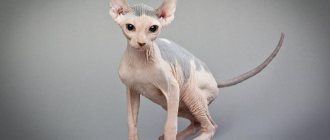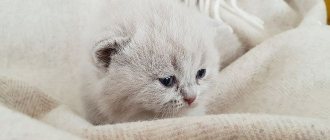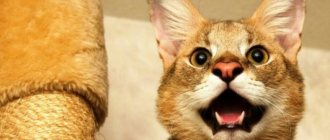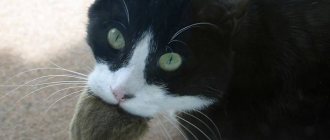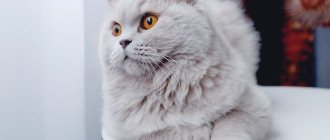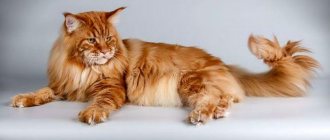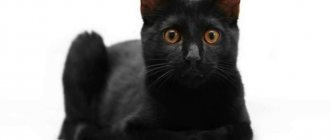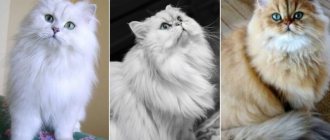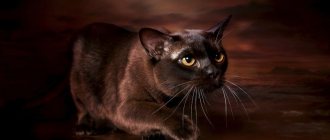Home » Other animals
Classification Species: Ocelot (Leopardus pardalis)
Family: Felines
Subfamily: Small cats
Squad: Carnivores
Class: Mammals
Genus: Tiger cats
Dimensions: Length from head to tip of tail - 100 -140 cm; height - about half a meter, weight - 10 - 16 kg
Lifespan: 7 – 10 years in nature, up to 20 in captivity
Ocelot is a small, strong and agile cat native to the jungles of South America; it runs well, climbs trees and swims wonderfully.
It is considered a sacred animal by many ancient cultures, but its beautiful and soft fur quickly attracted the attention of hunters.
In the twentieth century, the ocelot population was significantly depleted as it was intensively hunted.
Celot fur coats were valued much more than the fur of arctic fox , ferret and otter , their price reached up to $40,000, and cubs were sold as exotic pets for $800.
The extermination stopped when the animal was listed in the Red Book.
The population has increased, but is now greatly affected by deforestation of the area and the growth of settlements.
Interesting! The ocelot is believed to have been worshiped by ancient Peruvian tribes (similarly, the ancient Egyptians idolized the Egyptian Mau ), and their artwork often featured the beautiful ocelot.
The ocelot is an incredibly adapted animal that has been seen in a variety of habitats including rainforests, grasslands, mangroves and swamps where there is a lot of dense vegetation
- 2 Characteristics
- 3 Appearance
- 4 Behavior and lifestyle
- 5 Food
- 6 Reproduction
- 7 Breeding in captivity
Habitat
The ocelot is widely distributed from the extreme southern United States through Central and South America as far south as northern Argentina.
In the United States, some species have been observed in Louisiana, Arkansas, and Arizona, but the remainder of the population is now limited to southern Texas, with a few occasionally entering Arizona from Mexico.
It is most common in the South American tropics, in the dense jungles of the Amazon basin.
The ocelot is an incredibly adapted animal that has been seen in a variety of habitats, including rainforests, grasslands, mangroves and swamps, where there is a lot of dense vegetation.
Although the beast is usually found no higher than 1,200 m above sea level, animals have also been observed living, like red wolves , on the high slopes of the Andes at altitudes of up to 3,800 m.
As strong swimmers, they are also sometimes found in seasonally flooded forests and near populated areas.
The largest of the small spotted cats, the ocelot is one of the best known and most widespread felid species in its range, as well as perhaps one of the most beautiful.
Character traits
The ocelot is brought up in a playful way from childhood, showing intelligence and intelligence. Its habits resemble a cat and a dog at the same time. Loves to play with a ball and bring it to its owner. Walks on a leash, jumps and climbs trees, and swims in the pool. The animal is curious and studies new toys with interest. She is well accustomed to the litter box, but does not bury excrement.
Friendship with other animals is an extremely rare case, but it is still possible if a small kitten ends up in a house where there are already pets and grows up with them.
Characteristic
The largest of the small spotted cats, whose list includes Bengals , Toygers and Savannahs , the ocelot is one of the best-known and most widespread felid species in its range, as well as perhaps one of the most beautiful.
Externally, the animal is similar to a small leopard or a long-tailed cat, although it is larger than it, and smaller than a leopard.
Purchasing a kitten
The price of an ocelot in Russia depends on age, gender, coat color, pedigree, degree of tameness of the baby, and the number of acquired skills. Average cost $2 – 4 thousand.
You should not purchase an animal from dubious sellers; it is better to contact a nursery with a good reputation. The establishment’s staff will provide detailed information, clarify how much an ocelot costs, familiarize you with official documentation, provide advice and provide qualified assistance.
What else to see:
Appearance
The ocelot, whose photos are very attractive, has short, thick, velvety fur, ranging from dark yellow to reddish-gray in color with black chains of rosettes on the back and sides. Dark spots on the legs and stripes on the head and face are distinctive features.
The animal has a long tail, usually with dark rings, and large paws in relation to its body size.
There are also parallel black stripes on the neck where the fur grows "backwards".
The chin and belly are white. The ears are black, with white dots on the back side. Each ocelot has a unique coat pattern.
The ocelot cat is about a third smaller than the male, but is otherwise similar in appearance.
Outwardly, the animal is similar to a small jaguar or a long-tailed cat, although it is larger than it, and the jaguar is much smaller.
This is how the kitty sleeps
PhotoTelegraph
The ocelot, also known as the dwarf leopard, is native to South and Central America and Mexico, but has also been seen in Texas and Trinidad. Externally, the ocelot looks like a domestic cat. The color of its fur resembles that of a leopard or jaguar and was once considered especially valuable. As a result, hundreds of thousands of ocelots were killed for their pelts. From 1972 to 1996, this cat was on the list of endangered species. (22 photos)
discuss photo (0)
1. The Latin name for the ocelot is Leopardus pardalis. This cat lives in South and Central America. All cats of this genus are spotted, flexible and small. Ocelot is the largest of them. (FLASHFLOOD STUDIOS)
discuss photo (0)
2. The length of the ocelot varies from 68 to 100 cm, the length of the tail is 26-45 cm. Weight is 8-18 kg. (ANNE-MARIE KALUS)
discuss photo (0)
3. The ocelot has smooth fur, rounded ears and relatively large front paws. (BRIENNE EARNST)
discuss photo (0)
4. Baby ocelot. (Reddit)
discuss photo (0)
5. The ocelot is primarily a nocturnal animal and loves to defend its territory. (WAYNE DUMBLETON)
discuss photo (0)
6. Ocelot skin has long been a popular commodity. For example, in 1969, over 133 thousand skins were imported into the United States. In the 1980s, ocelot fur coats sold for $40,000, and a live ocelot as a pet sold for $800. (JIM NICHOLSON)
discuss photo (0)
7. Due to intensive hunting for it, the ocelot has become an extremely rare animal in our time. Thanks to new interstate agreements, hunting of ocelots, as well as the sale of any products made from ocelots, are prohibited. (DAVID RIVERA)
discuss photo (0)
8. Like most cats, ocelots are loners. They meet only to mate. (Hotel Lyric)
discuss photo (0)
9. During the day, these cats sleep in trees or in dense foliage and can sometimes share their “bed” with an individual of the same sex. (E_MONK)
discuss photo (0)
10. Males occupy a territory of 3.5 to 40 km², and females occupy smaller territories of 0.8-15 km², which do not overlap with the territories of males. (TOM SMYLIE, US Fish & Wildlife Service)
discuss photo (0)
11. Ocelots hunt mainly small mammals (various rodents), reptiles and amphibians (lizards, turtles and frogs), crabs, birds and fish. (LOOPY PHOTOS)
discuss photo (0)
12. Compared to other small cats, ocelot cubs grow very slowly. (FLOR DE LA AMAZONIA)
discuss photo (0)
13. At birth, the cubs weigh about 250 g, and their eyes open only after 15-18 days. (TIM CHEESMAN)
discuss photo (0)
14. They begin to leave the den at three months, but remain with their mother until they are two years old, and then go off to look for their own territory. (GLENN SHOEMAKE)
discuss photo (0)
15. Like many wild cats, ocelots often act as pets. (PAUL FERNANDEZ)
discuss photo (0)
16. In captivity, ocelots live up to 20 years. (E_MONK)
discuss photo (0)
17. The Salvadoran department of Usulutan owes its name to the ocelot. Translated from the Nahuatl language, it means “city of ocelots.” (FILIPPO PHOTOS)
discuss photo (0)
18. The Moche, the people of ancient Peru, worshiped these animals and often depicted them in their art. (DANLEO)
discuss photo (0)
19. Musician Gram Parsons kept an ocelot in his backyard in Florida in the mid-60s. (ANNE-MARIE KALUS)
discuss photo (0)
20. Salvador Dalí often traveled with his pet ocelot Babou, even taking him on board the luxury airliner SS France. (B. TSE)
discuss photo (0)
21. (NATUREPUNK)
discuss photo (0)
22. (Midnight Giraffe)
# animals, cats
Behavior and lifestyle
- The ocelot is a solitary animal that occupies a habitat of up to 30 square kilometers. Males tend to patrol the territory.
- The ocelot is a nocturnal animal. During the day he sleeps in dense vegetation or on a tall and green tree.
- It has excellent vision, touch and hearing, which help it hunt at night.
- The animals communicate with each other using soft meows, which turn into loud screams when searching for a partner.
The ocelot is active 12 hours a day and can travel distances of up to seven miles. Their female colleagues travel with males
- The ocelot is an incredibly secretive animal; it is rarely seen in natural conditions; the animal skillfully hides in dense vegetation, coming out into the open only at night.
- The ocelot is active 12 hours a day and can travel distances of up to seven miles. Their female colleagues travel with the males.
- The ocelot is a strong swimmer as well as an agile climber, although most of its hunting and traveling takes place on land.
Domesticated ocelot can eat from a bottle
Life of an ocelot at home
Thanks to its aesthetically beautiful exterior, many wealthy people dream of having this animal live in their home as a pet cat. Such animals are kept in home-equipped nurseries.
To do this, newly born kittens are immediately taken from the cat and then fed from a bottle or syringe. In this way, adaptation to humans is easier and cats grow up to be very affectionate and non-aggressive. At the age of five months, cats must be neutered so that they do not mark their territory.
If you plan to breed an ocelot, then it is worth keeping the animals in special enclosures in which they are isolated from each other and from people.
Space is very important for the animal, and it is also necessary to create conditions close to wild nature. The animal is quite active and sometimes wants to run around, so before buying an animal, the future owner needs to take care of the territory where the predator will be kept.
If it is not possible to allocate a fairly large area, then you need to abandon this purchase and choose another pet. If there is not enough space for the ocelot, it will lose its shape from idleness and fall into a kind of depression.
The ideal option for keeping such an unusual pet is a private house, on the site of which there is an enclosure measuring at least fifteen square meters . The enclosure must be equipped inside. Trees, snags, stones - this is what the animal needs.
Diet of the domestic ocelot
The ocelot leopard's diet is based on animal food, just as in the wild. The animal needs meat, it can be chicken, beef or rodents.
You can diversify the diet occasionally with eggs, fish, and also specialized dry food of the highest quality. Pork is contraindicated for ocelots. Until the age of three, cats need to be given vitamins enriched with calcium.
The cat needs to be fed twice a day, according to a strictly established regimen. Food should not be cold. The daily volume is about 400 grams .
The owner must remove any uneaten leftover food to avoid poisoning the animal.
Nutrition
The ocelot is a carnivore, hunting for food under the cover of darkness and stalking prey primarily on the ground.
Although small mammals such as rodents make up the majority of its diet, it is known to prey on other small animals including rabbits, birds, fish, crabs, lizards and snakes, and will even take a small deer on occasion.
These wild cats are also known to eat monkeys, turtles, armadillos, anteaters and kill domestic birds when food is scarce.
The animal uses fangs to kill and sharp front teeth to tear food.
They do not have teeth for chewing, so they tear food into pieces or swallow it whole.
Their hard tongue will easily clean the bones down to the last tasty morsel.
In the heart of the tropics, ocelots breed year-round, but in the northernmost and southernmost areas of their natural range, breeding season occurs in late summer and fall.
Reproduction
In the heart of the tropics, ocelots are known to breed year-round, but in the northernmost and southernmost areas of their natural range, the breeding season occurs in late summer and fall.
After mating, the female finds a cave in the rocks, a hollow tree, or makes a nest in a dense and thorny thicket to have some privacy and protection while she prepares to give birth.
After the gestation period (75 to 85 days), the female usually gives birth to one kitten, rarely two or three.
They are born blind and have fine, dark fur. Within a month, ocelot kittens begin to see clearly, and their fur becomes much denser and more colorful.
Babies feed on mother's milk from 3 to 9 months. Although kittens are fully grown by one year and are capable of becoming independent, they often remain with their mother for several years before leaving her to live on their own.
A female ocelot gives birth once every two years.
In order for an ocelot kitten to grow up to be tame, playful, and not angry, it must be purchased from a reputable home nursery. You should pick him up as a toddler, before his eyes open, feed him from a nipple, constantly take care of him, and play with him.
Reproduction
Sexual maturity occurs in ocelots at 1.5 years. For males, this process takes a little longer; they are ready to reproduce by about 2 years. There are no specific dates for mating among representatives of this breed, but still more often mating occurs in the period June-October.
The duration of pregnancy is 2.5 months. There is only 1 kitten in a litter, less often two cute little ocelots are born. The female feeds with breast milk until the cub is 2 months old, after which they begin to taste meat.
For 2 years, the cubs are absolutely dependent on their mother.
Unlike most wild cats, the male does not leave the female immediately after fertilization. He is next to her, obtaining prey for the kittens, which open their eyes 14 days after birth. The male is also responsible for protecting the burrow in which his offspring are located. At first, the cubs go hunting only when accompanied by adults. And later, learning habits and skills, they can hunt on their own.
